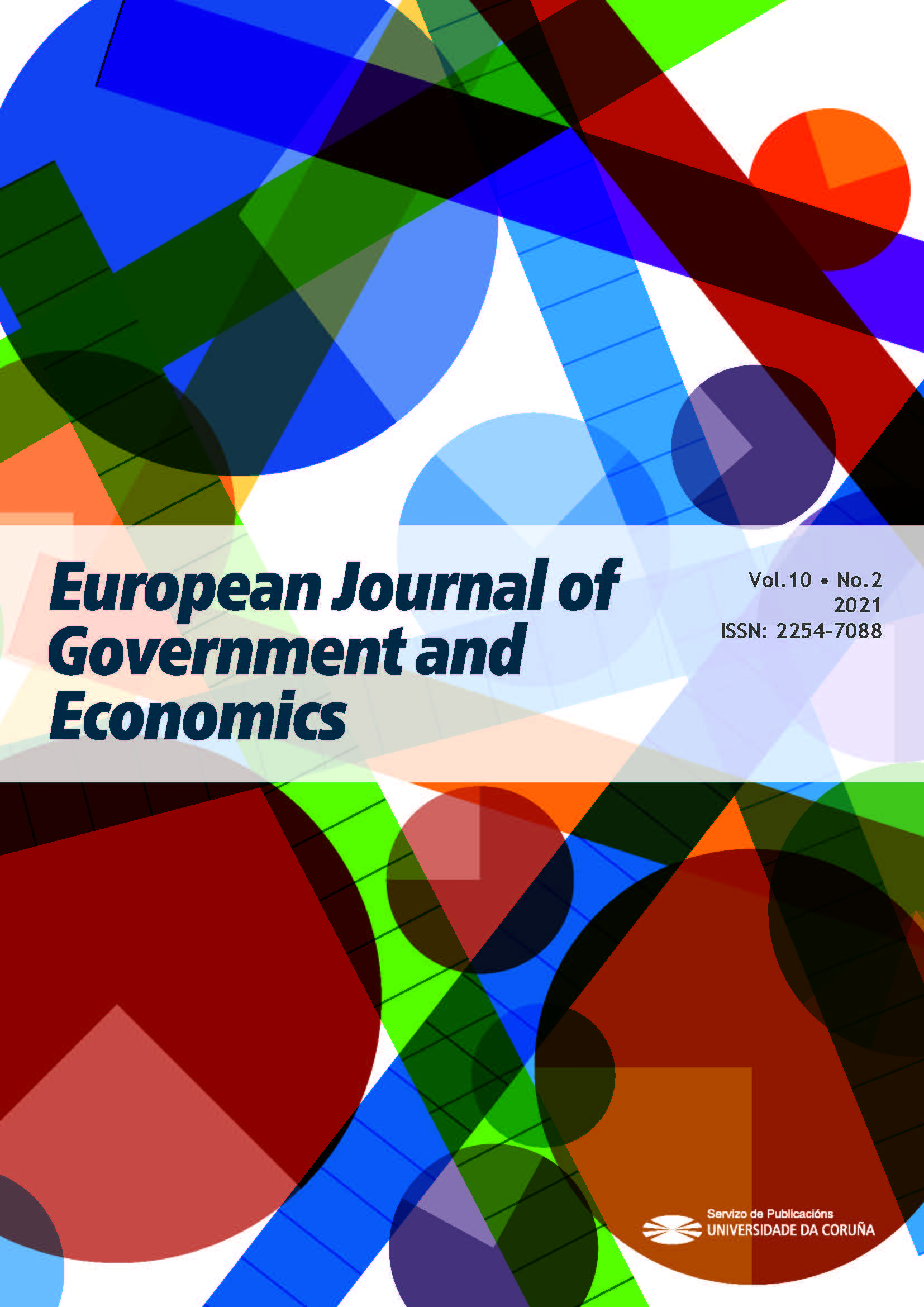Assessing the optimality of euro adoption in Romania through shock correlations
Main Article Content
Abstract
The present paper is concerned with the prospect of euro adoption in Romania. The study starts from the relevant literature of the Optimum Currency Areas and identifies the most widely acknowledged meta property and methodological model for this purpose: the SVAR Blanchard and Quah decomposition for identifying the supply and demand shocks. Employing the indicated model and the most recent data, we are able extract and analyse the underlying shocks that hit 34 European economic entities in the period 1995-2019, while also taking into account two crucial structural changes for the Romanian economy – central bank independence and EU accession. After performing the pairwise correlations between Romania and the rest of the economic entities for both the supply and demand disturbances, we map them on a bidimensional graph. We discover that while there is relevant integration and connectedness that ensures relatively high correlations between supply shocks, the politically-motivated monetary and fiscal policy disturbances that created ample and hectic demand side movements, are a factor of great concern for the prospect of single currency adoption in this Eastern European country. The findings support the view that there is room for the conduct of macro policies to become more supportive to the process of euro adoption and that the respect of convergence criteria would help in this respect. To our knowledge, this is the first study performing pairwise shock correlations between Romania and many other European economic entities, while also isolating the effect of post 2005 structural changes.
Keywords:
Downloads
Article Details
References
Arčabić, V., & Škrinjarić, T. (2021). Sharing is caring: Spillovers and synchronization of business cycles in the European Union. Economic Modelling, 96(C), 25–39. https://doi.org/10.1016/j.econmod.2020.12.023
Artis, M. J. (1991). One market, one money: An evaluation of the potential benefits and costs of forming an economic and monetary union. Open Economies Review, 2(3), 315–321. https://doi.org/10.1007/BF01886149
Bayoumi, T., & Eichengreen, B. (1993). Shocking aspects of European monetary integration (F. Torres & F. Giavazzi, Eds.; pp. 193–235). Cambridge University Press. https://doi.org/10.1017/CBO9780511599231.014
Bayoumi, T., & Eichengreen, B. (1996). Operationalizing the theory of optimum currency areas. In CEPR Discussion Papers (No. 1484; CEPR Discussion Papers). C.E.P.R. Discussion Papers. https://ideas.repec.org/p/cpr/ceprdp/1484.html
Blanchard, O. J., & Quah, D. (1989). The dynamic effects of aggregate demand and supply disturbances. The American Economic Review, 79(4), 655–673. http://www.jstor.org/stable/1827924
Bobeica, E., & Manu, A. (2013). Empirical analysis of business cycle synchronization and shock similarity between Romania and the Eurozone. Emerging Markets Finance and Trade, 49(4), 74–97. Scopus. https://doi.org/10.2753/REE1540-496X490404
Bodea, A., & Sánchez-Santos, J. M. (2020). Seigniorage and inflation tax in Romania. What is the executive giving up by adopting the euro? Scientific Annals of Economics and Business, 67(1), 75–91. https://doi.org/10.2478/saeb-2020-0004
Campos, N. F., & Macchiarelli, C. (2016). Core and periphery in the European Monetary Union: Bayoumi and Eichengreen 25 years later. Economics Letters, 147, 127–130. https://doi.org/10.1016/j.econlet.2016.07.040
Corden, W. M. (1972). Monetary integration, essays in international finance. International Finance Section, 93, 1–45.
de Grauwe, P. (2018). Economics of monetary union. Oxford University Press.
Demertzis, M., Hallett, A. H., & Rummel, O. (2000). Is the European Union a natural currency area, or is it held together by policy makers? Weltwirtschaftliches Archiv, 136(4), 657–679. https://www.jstor.org/stable/40440810
Deskar-Škrbić, M., Kotarac, K., & Kunovac, D. (2020). The third round of euro area enlargement. Are the candidates ready? Journal of International Money and Finance, 107, 102205. https://doi.org/10.1016/j.jimonfin.2020.102205
Emerson, M. (1992). One market, one money. An evaluation of the potential benefits and costs of forming an economic and monetary union. Oxford University Press on Demand.
Fidrmuc, J., & Korhonen, I. (2003). Similarity of supply and demand shocks between the Euro Area and the CEECs. In Royal Economic Society Annual Conference 2003 (No. 77; Royal Economic Society Annual Conference 2003). Royal Economic Society. https://ideas.repec.org/p/ecj/ac2003/77.html
Forni, M., & Reichlin, L. (1997). National policies and local economies: Europe and the United States (CEPR Discussion Paper No. 1632). C.E.P.R. Discussion Papers. https://econpapers.repec.org/paper/cprceprdp/1632.htm
Frenkel, M., & Nickel, C. (2002). How symmetric are the shocks and the shock adjustment dynamics between the Euro Area and Central and Eastern European countries? (SSRN Scholarly Paper ID 880912). Social Science Research Network. https://papers.ssrn.com/abstract=880912
Frenkel, M., Nickel, C., & Schmidt, G. (1999). Some shocking aspects of EMU enlargement. SSRN Electronic Journal. https://doi.org/10.2139/ssrn.164551
Funke, M. (2000). Macroeconomic Shocks in Euroland vs the UK: Supply, Demand, or Nominal? In Quantitative Macroeconomics Working Papers (No. 20001; Quantitative Macroeconomics Working Papers). Hamburg University, Department of Economics. https://ideas.repec.org/p/ham/qmwops/20001.html
Giavazzi, F., & Giovannini, A. (1989). Limiting exchange rate flexibility. The MIT Press. https://mitpress.mit.edu/books/limiting-exchange-rate-flexibility
Grimm, L., Steinkamp, S., & Westermann, F. (2021). On optimal currency areas and common cycles. Are the acceding countries ready to join the euro? (SSRN Scholarly Paper ID 3830221). Social Science Research Network. https://papers.ssrn.com/abstract=3830221
Ishiyama, Y. (1975). The theory of optimum currency areas. A survey. Staff Papers (International Monetary Fund), 22(2), 344–383. https://doi.org/10.2307/3866482
Issing, O. (2004). Economic and Monetary Union in Europe. Political priority versus economic integration? In B. Ingo, C. Volker, & S. Bertram (Eds.), Political Events and Economic Ideas. Edward Elgar Publishing. https://EconPapers.repec.org/RePEc:elg:eechap:3131_2
McCallum, B. T. (1989). Monetary economics: Theory and policy. Macmillan ; Collier Macmillan.
McKinnon, R. I. (1963). Optimum currency areas. The American Economic Review, 53(4), 717–725. https://www.jstor.org/stable/1811021
Mongelli, F. P. (2002). “New” views on the optimum currency area theory. What is EMU telling us?
Mundell, R. A. (1961). A theory of optimum currency areas. American Economic Review, 51(4), 657–665.
Pfaff, B. (2021). BQ function. R Documentation. https://www.rdocumentation.org/packages/vars/versions/1.5-3/topics/BQ







